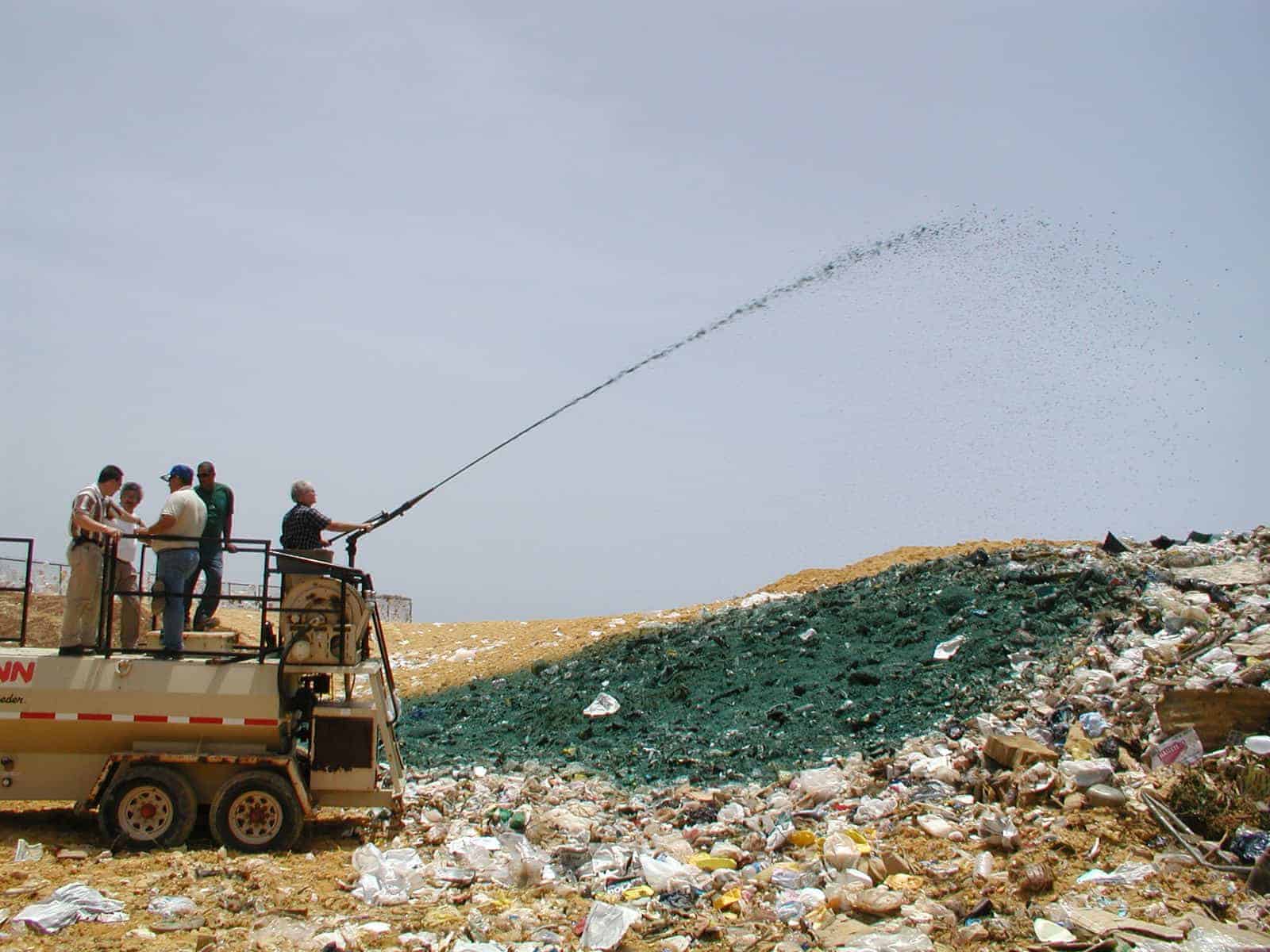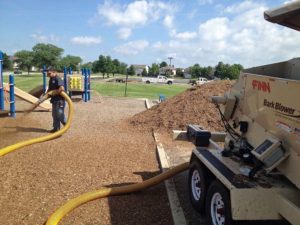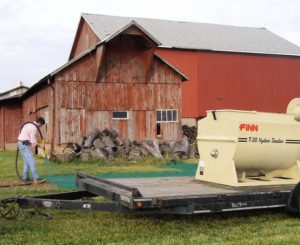Landfill Alternative Daily Cover 101

Share this article!
Traditional landfill management includes the application of a daily cover — typically and historically soil — to maintain as safe and hazard-free landfill site as possible. Alternative Daily Covers (ADCs) were introduced in 1993 when the Environmental Protection Agency (EPA) outlined federal regulations for using landfill covers other than soil.
These ‘alternative’ daily covers are made from a variety of materials, which can differ state to state based on regulations, though they’re generally made from materials like shredded tires, green waste or compost, foam products, fabric panels, or construction waste. Some waste cover systems even form a rigid crust over the site adding protection against scavenging and runoff, as well as other landfill concerns like disease control and pollution.
Alternative Daily Cover for Landfills
Federal regulations require that landfill waste be covered at the end of every day, and this has often been accomplished by applying soil (at least 6 inches in depth) or shredded paper. These materials have several disadvantages when it comes to containing landfill waste because they’re susceptible to forces like erosion, vermin, and even simple wind gusts.
Because there are now a variety of landfill cover materials that can be adapted for use as alternative daily covers, landfill operators have more options to comply with federal regulations and prevent safety and public health issues related to landfills.
Types of ADC:
Many landfills operate using one or a combination of the available and federally-approved types of alternative daily covers:
- Green Waste — Green waste ADCs are generally biodegradable and made from yard bin waste like grass and bush clippings, branches, leaves, bark, and even weeds.
- Compost Materials — Composted, or partially decomposed materials like wood, green waste, or other solid waste can be used as an ADC and has several benefits for landfill use including acid reduction.
- Ash — Burned materials, often burnt wood or coal, are used as ADCs in conjunction with soil or sludge to increase its effectiveness as a landfill cover.
- Shredded Tires — Shredded tires can be a great option for landfills, because in addition to reducing rubber waste in the landfills themselves, they can instead provide an effective landfill cover material.
- Auto Shredder Residue (ASR) — ASR is a non-metallic waste product generated from metal reclamation processes, the chief contributors of which are commercial and residential vehicles and major appliances.
- Geosynthetic Covers —These types of landfill covers are made from plastic or fabric materials, and can be laid out over the landfill site to cover waste like a tarp.
- Hydromulching or Spray On — This type of alternative daily cover uses materials like wood or recycled paper blended with a slurry of water which sprays on the landfill creating a crust-like surface about ¼ inch thick.
Benefits of ADC
Using traditional soil coverage for landfills has several drawbacks, not the least of which is the time and labor involved to apply. As a result, spray-on alternative daily covers come with advantages that soil alone often can’t compete with including:
Improve Landfill Life & Capacity
Alternative daily covers and sprayed on ADCs require a fraction of the space to effectively cover a landfill when compared with soil. Because ADCs are applied daily, over time, this space savings adds up quickly to a considerable amount of increased capacity for landfills of all kinds.
This volume savings not only allows landfills to handle more waste, it can facilitate landfill operations for the long run, saving as much as 10-15% in waste volume over the course of years or decades.
Odor Control
It’s no secret that landfills can be smelly, but with the right alternative daily cover, related odors are significantly reduced so that neighboring homes and businesses don’t have to deal with this unfortunate by-product of landfills. ADCs, like spray ons and hydromulching, are especially effective at limiting landfill odors as they provide a rigid barrier over daily waste.
Fire Prevention
Layers and layers of waste can create dangerous and flammable conditions if not managed properly. That’s why federal regulations require waste to be covered according to a strict set of specifications to prevent combustion. Alternative daily covers adhere to these regulations by reducing flammable conditions in the landfill and helping prevent waste fires quickly and effectively.
Scavenger and Disease Transmission Control
Wherever you have volumes of waste products, the potential for disease and vermin exists, which is another important reason landfills are carefully regulated on the federal level. Daily covers help prevent both scavenging by birds like seagulls, other vermin like rodents, pests, insects, and the associated disease spread by limiting access to, and the appeal, of daily waste.
Cost Savings
Covering a landfill with a minimum of 6 inches of soil each day is a substantial undertaking when you consider the materials and manpower involved. Dirt has to be extracted from a location, moved to the landfill, and distributed over a large area up to the required depth. This generally takes a team of individuals, many tools, heavy machinery, and a considerable amount of time.
By comparison, spray-on alternative daily covers can often be applied to a large surface area by two people and a single truck. For example, the Finn LF120 can apply coverage to ⅕ of an acre on one tank, and the application process generally takes less than an hour.
Methods for Applying Landfill ADC
Applying landfill ADC, and the advantages of spray-on cover for landfills, can be relatively easy to achieve, especially compared to traditional soil alternatives. With the right equipment and a little training, applying landfill ADC can be quick and effective. While applying ADCs like tarps and geosynthetic covers can be more labor intensive, spray-on covers are an effective and time-saving option.
Finn Hydroseeders for Daily Landfill Cover
Hydroseeders are ideally-suited for applying landfill alternative daily covers. With features like:
- Durable, high-capacity tanks for handling large volumes of ADC,
- Hydraulic agitators to keep materials well-mixed and balanced,
- High ground clearance,
- Tower discharge distances that reach up to 180’,
- And rugged, reliable design,
The Finn LF 120 can handle the extreme environments of landfills with precision and ease. They are also designed to be used easily and effectively by a few individuals, so a relatively small team of people can cover a landfill area in a short amount of time.
How does alternative daily cover differ from intermediate and final cover systems?
Alternative daily covers are applied to a landfill’s ‘open surface’ each day. By comparison, other types of covers can be approved for use in landfills like intermediate and final cover systems.
Intermediate covers are generally used when a landfill, or portion of a landfill, is scheduled to be inactive for a period longer than 180 days. In this scenario, an intermediate cover of at least 12 inches in depth must be applied to comply with regulations.
Final cover systems are used when a landfill has reached its full capacity. These covers are generally designed with multiple layers — usually clay, synthetic, drainage, and topsoil — according to the specifications of the landfill, so that the landfill area can be safely and effectively retired when it has reached the end of its useful life.
Takeaway
Landfill covers are a necessary part of landfill operations, and with the right equipment and knowledge, you can keep your landfill running efficiently, increase its capacity, extend its lifespan, and meet federal regulations all at once.
For more information about landfill alternative daily covers, waste covers, or hydroseeding alternative daily covers, explore the resources below or contact us today.
Folow Finn Corporation on Social
How to Lay Mulch Evenly – When & Why to Use a Mulch Blower
Understanding the best way to spread mulch evenly can mean the difference between a great-looking, environmentally-friendly landscape, and one that falls short in both areas. From spreading mulch basics to how to spread mulch evenly, and when to use a mulch blower to achieve the desired results, these landscaper insider tips can help elevate your next project’s aesthetics and help…
Bark & Mulch Blowing 101
One of the best ways to enhance soil composition, prevent erosion, and improve the aesthetics of any landscaping project is to utilize bark and mulch blowing. For our purposes, bark and mulch blowing are effectively the same thing, and can generally be used interchangeably. Bark and mulch are both great choices to prevent weed growth and invasion, improve soil quality…
Hydroseed vs. Sod vs. Grass Seed
If you’re starting a lawn from scratch, you’ve probably come across the three common methods for seeding: sod, grass seed, and hydroseed. In order to determine the best choice for your yard, you may want to ask yourself a few questions before you get started, and familiarize yourself with each of the processes so you can make the right choice…



